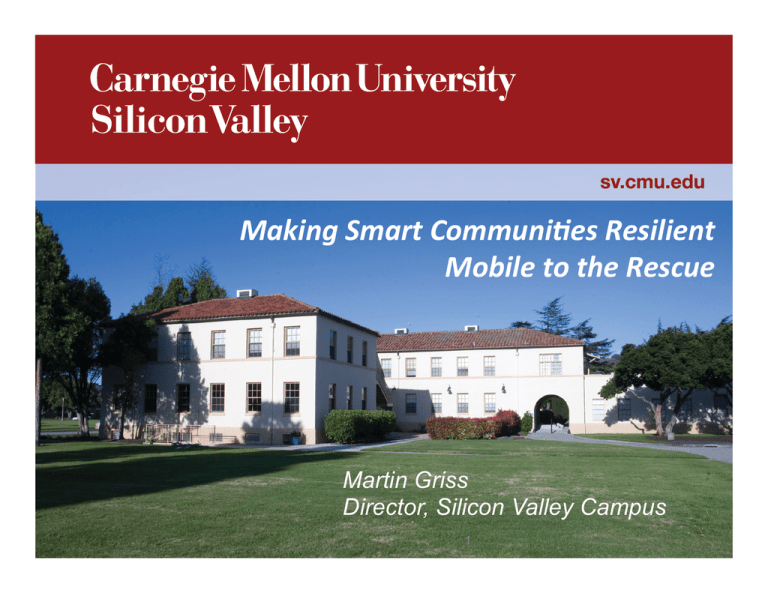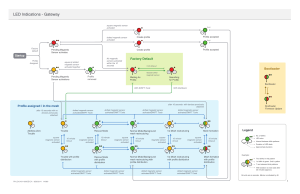Document 13104818
advertisement

Making Smart Communi/es Resilient Mobile to the Rescue Martin Griss Director, Silicon Valley Campus 1 Carnegie Mellon Silicon Valley • • Established 2002 High-tech ecosystem • • • 180 students 745 alumni 55 faculty/researchers Enriching Anywhere, Anytime Computing Goals • • • • • Prototype novel mobile applications, devices & systems Perform multi-disciplinary research Do holistic, synergistic work Experiment with large scale pilot(s) Create collaborative community Established April 2008 • Workshops and hackathons on : o o o o o Security Mobile Health Disaster Management Smart GRID Novel applications Mobile & SMS is Dominant Worldwide Population 7B 6B Mobile phones 5B Smart phones 4B 3B Phones becoming smaller, cheaper, smarter SMS users SMS dominates • 7.8 T SMS sent in 2011 ~ 9 T in 2012 • 250 B MMS in 2011 2B 1B Mobile Internet Facebook YouTube Twitter LinkedIn Web of Things: Disruption 10X the Opportunity THINGS 50 B PEOPLE 5.0 B Digital Society Sustainable World Personal Mobile Inflection points Global Connectivity 1875 Source: Ericsson 1900 PLACES ~0.5 B 1925 1950 1975 2000 2025 © Ericsson AB 2010 Mobile computing . Security CMU-SV Research . Voice recognition Context-aware applications . Human identification . Wireless sensors Antennas & MEMS Machine learning, Behavior recognition . . Business Reuse Faciliated Reuse. Energy . Disaster Management . Managed Reuse . Big data Software engineering . Architected Reuse Immersion Reality . Smart Communities . • • • • • • • Open access, open source, interoperable Mobile, Social, Cloud, Sensors All-­‐hazards Regional, community Situa@on maps Ci@zen involvement Prac@cal solu@ons Coordinating, Collaborating, Aggregating location, images, videos, information Citizens Emergency Responders crowdsource, notifications, coordination filtering, fusing data (Mobile) Command Centers instructing, resource allocation Coordinating Multiple Participants Cell, SMS?, Facebook? Twitter? LMR Ordinary Citizens 911 Dispatch Center Professional Responders amateur radio, FRS . LMR, … , o i d a r amateur Emergency Operations Center CERT Teams NGOs Companies, media, etc. SMS-Based First Responder Tool Leverage Community Mobile Phones Civilians may have smartphones with residual battery, but cell & Internet can be unavailable Silicon Valley Resilient Network An “internet” when all else fails Level I The Neighborhood “Bubble” Local-only VoIP and core data services to smartphones Level II Level III Limited Public Internet Augment the bubble with satellite and QoS management Neighborhoods Linked to City Solar / battery-backed dedicated network infrastructure Silicon Valley Resilient Network Database Server Database RESTful interface, JSON payloads Gateway Gateway Gateway Gateway IPv4 / IPv6 Survivable Social Network Situation Hyperwall Palo Alto MEOC Sensor Networks Survivable Social Network Focus on communities – Neighbors supporting neighbors Key idea: Social Network “in a box” – Familiar look and feel – No installation needed – Training-less Minimal infrastructure – A laptop computer, or small server – Simple WiFi access point – Smartphones w. HTML5 browser – Uses Elg, Asterisk, SIP, … Semantic Geotagging Smartphone/tablet for first responders to add semantically linked geo-tagged annotations to the Common Operating Picture … ! … Shared Situation Hyperwall • Critical to prioritize, work effectively, & coordinate • Multi-screen, common operating picture • Mobile phone and Kinect interaction ! Shared Situation Hyperwall • Polls the database for “interesting” info • Interactive, multimedia interface • Real-time updates – AJAX-based • Messages / pictures • Selective tracking (breadcrumbs) • Scalable interface – laptop to big screen • Triage reported problems (e.g., CERT trailer), escalate Next Gen Emergency Operations Center Solar Powered Host NASA Mission Control for Wildfire UAVs Satellite Comms Community WiFi 3rd Annual DMI Workshop Nov 4-5, 2012 Making Smart Communities Resilient: Use network, mobile, social, sensor, information technology CMUSV integrated smartphones, voice, data, location, situation awareness, mobile vehicle interoperability Mobile Mesh A unified, delay tolerant mesh network for instantly available communication using Wi-Fi Smartphone Mesh “I'm OK” “I have clean H2O” “I am 3Gconnected” “I'm trapped” Smartphones can bootstrap a secure ad hoc or mesh network for local communication Delay-Tolerant Networking Application is unaware of DTN DTN Meshes Delay tolerant meshes can cover very large areas, limited only by mobility and acceptable application demands, reducing density of PoCs 23 Heterogeneous Mesh Various device classes can connect using gateways/“translators” between them 802.11g/n 802.11 ad hoc 802.11s mesh 3G/4G 24 Smart Communities - Sensor Networks Web of Things Sensor Network Campus Campus Network Network Ethernet End-User Server Ethernet Agents End-User munication Requirements Gateway Sensor Device 802.11 Gateway RS-232 Sensor Device Ethernet / 802.11 IP Camera RS-232 PC RFID RX Actuator 802.15.4 Bluetooth Sensor Mobile Node Fig. 1. The three-tiered Sensor Andrew Architecture. tion. The communication layer should allow for CMUSV B23 Test Bed 213 Martin Chris Pei Patrick Jason Collin Scott Joy Lounge Mikelynn Gerry Stacy Sylvia L Dan Sylvia A Ngoc Men’s Room Stairs Coffee Hector PR Cubes Sensor Board (25-­‐30) Gateway (1 or 2) PR Mobile Locationing Determine occupancy • Indoor localization • Indoor orientation detection Context-Awareness • Detecting the context of a user • Physical Context • Location, Activity, Proximity, etc. • Psychological Context • Virtual Context • Emails / IMs received, calendar state, etc. • Faster development of context-aware applications • Abstraction to hide complexities of, • Resource management – • • • Battery power Bandwidth Processing power • Security • Usability • Automated detection of context Machine Learning Big Data Analysis • Modeling human behavior • • • • Predicting behavior Anomaly detection Activity detection Location detection • Bayesian & HMM predication • • • • Sensor fusion Federated reasoning System diagnosis Predicting probability of future states Some R&D Issues • Making these technologies robust and easy to use • Software engineering methods for loosely coupled systems: services, mobile, sensors, cloud, gateways, fog • Pushing computation to the edge (from Cloud to Fog) • Provide consistent naming and directory services • Managing scale, distribution, installation • Managing heterogeneous, federated mix of devices, gateways, services, languages, cloud Corporate Relationships Questions




